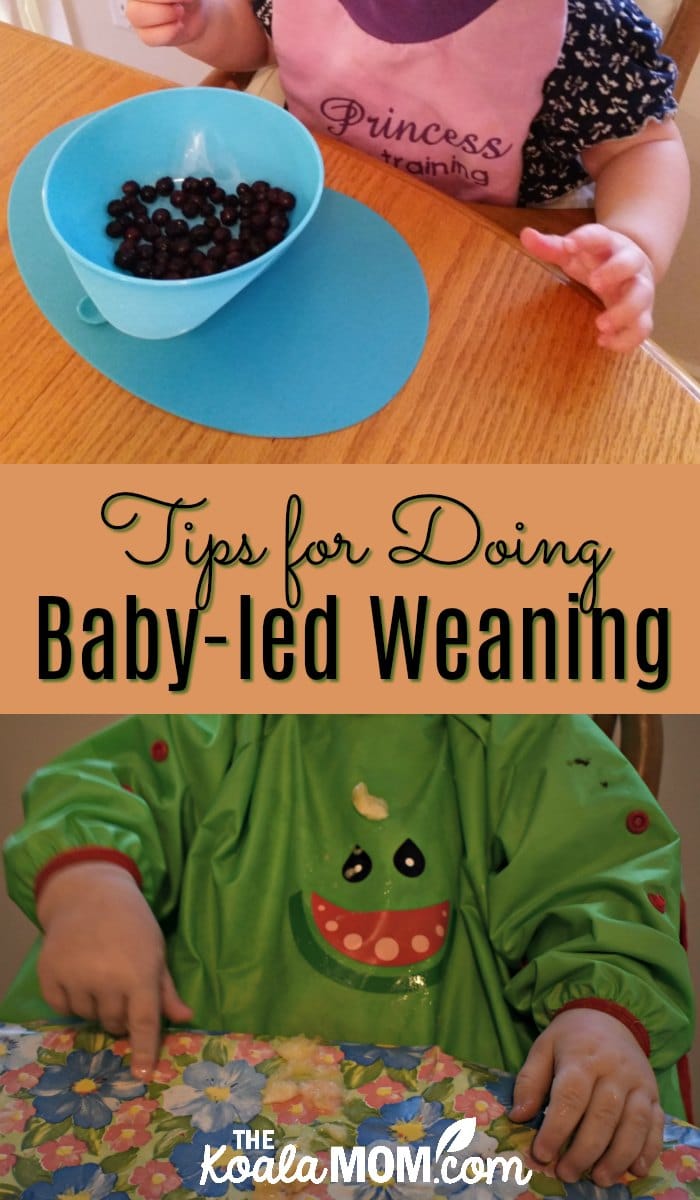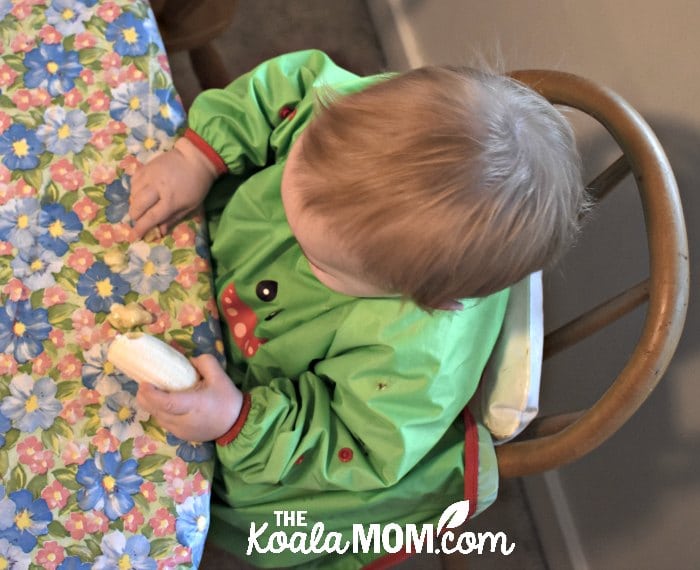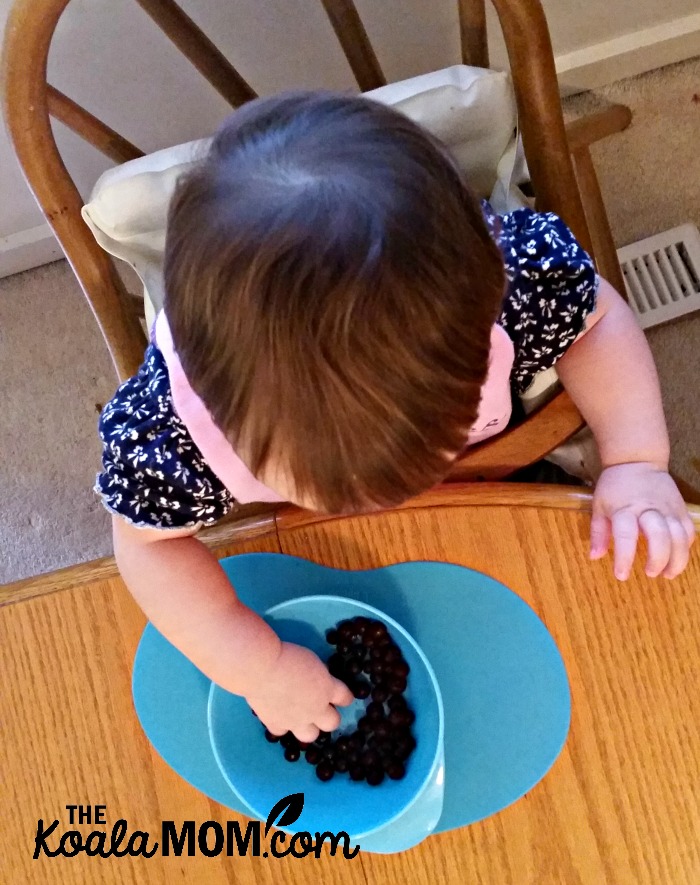They say your parenting changes with each baby you have. I’ve seen that most clearly in my approach to introducing my babies to solid foods. With my oldest, I followed the progression from breastmilk to baby cereal to pureed foods to solids. By the time my third came along, she was eating whatever bits of food I thought she could gum down. While I’ve found baby-led weaning a convenient and easy way to keep the baby happy, it’s also a great way to introduce your baby to solids.
If you think your baby is ready to move onto some foods besides milk, here’s my tips for doing baby-led weaning.

First, let’s clearly specify what we mean by baby-led feeding or baby-led weaning. Mama Natural explains,
“baby-led weaning is an approach to introducing solid food where baby is allowed and encouraged to self-feed solid finger foods instead of receiving purées via spoon. … baby led feeding may be a better term as BLW is not about weaning babies off breastmilk or formula, but is weaning them onto solids.”
With baby-led weaning, I let my baby:
- sit in his high chair with the family for meals
- feed himself appropriate finger foods (see below)
- decide how much and what he wants to eat
- continue to nurse as often as he wants
- drink water from a sippy cup or bottle
Use a Good Bib for Baby-led Weaning
While letting your baby feed himself can be easier than spooning food into his mouth, it’s also messier. Babies at this stage are still working on their hand-eye (or hand-mouth) coordination. Expect a lot of your baby’s food to end up in his lap, on his shirt, or on the floor around his high chair. (Did you know bananas leave a brown stain when smashed into a onesie?)
A good bib is essential for baby-led weaning. I was recently asked to review the Bibado and fell in love with it. This bib covers Joey entirely while he’s in his high chair, from his neck to his wrists. The bib even covers his high chair, which makes it a lot easier to clean up. (I wish I’d had this with my first—it would have saved me a lot of time scrubbing food off our wood high chair!).
Eat with Baby
While baby is learning to eat by himself, he shouldn’t be left unsupervised. I usually put Joey in his high chair when we’re eating as a family, or when the other girls are having a snack. This way I can see how he’s reacting to the foods he’s trying, and make sure that he’s not choking on anything.
Often, I’ll give Joey bits of food from my own plate. The other night, we had chicken pot pie for supper. I picked out the chunks of potato for him to try (and he loved them). I always check his food on my tongue or bottom lip to make sure that it’s cool enough.
Letting him eat off my plate during baby-led weaning is a good way to see what he likes or doesn’t like. I can just give him a bite of my food and see how he reacts, instead of opening a jar of expensive pureed baby food to find out that he won’t eat it.
Babies love to copy their older siblings and try to grab food from their plates and are often much happier if they are allowed to feed themselves. ~ BabyCenter
Skip the Dishes
When starting baby-led weaning, I usually just put food on the table in front of baby. In my experience, a plate in a baby’s hand is just a more efficient way to wing the food to the floor (or the wall). If I do put Joey’s food in a bowl, I’ll put his bowl beside my plate and just place three or four bites from the bowl in front of him. When he finishes that food, he gets more from his bowl.
For some messier foods, I use a Tommee Tippee baby bowl and mat. This lets me stick Joey’s bowl to the table, so he can’t throw his food on the floor in one fell swoop. As he gets older, and starts to use a spoon, I’ll start using this bowl more. Having the bowl stick to the table makes it easier for him to learn how to scoop food out of it and into his mouth.
Joey is almost 1 now and just attempted to use a baby fork for the first time. He’s very observant of what the rest of us are doing. He really wanted the fork, so I gave it to him to see what he’d do with it. We all had fun watching him jab his fork at his noodles, though he wasn’t very successful at actually getting anything on the fork—or into his mouth when he did.
Follow your baby’s cues about when he’s ready for a bowl or plate and a spoon or fork. Utensils require a lot more hand-eye coordination than simply using hands. For now, Joey has a couple small round forks he can hold while he’s eating. I remember my older girls holding a utensil in one hand and eating with the other for a stage.
I do let Joey have a sippy cup of water at meals. This is the one thing (other than food) that I place within arms’ reach for him at the table. If he indicates he wants some water, then I’ll help him hold his cup. He’s still not quite able to tip it up far enough to drink without getting air.
Great Foods for Baby-led Feeding
Some of Joey’s favourite foods are:
- my sliced canned peaches, cut in bite-sized pieces
- cooked frozen peas
- banana
- avocado
- potatoes or sweet potatoes
- ripe berries such as blueberries and raspberries
I start with foods that are gentle on baby’s tummy, like banana and avocado. As baby gets older, I add more foods. One of Joey’s favourite foods right now is a fried egg, chopped into small pieces.
If you have a family history of allergies, be careful about introducing possible allergens such as peanut butter, egg whites, or seafood. None of our kids have had any allergies. Pearl actually introduced Joey to peanut butter fairly early, when she shared her peanut butter sandwich with him. (He loved it.) If you have older kids, talk to them about who is allowed to feed the baby (only Mommy or Daddy!).
What tips would you share for doing baby-led weaning?



No Responses Yet